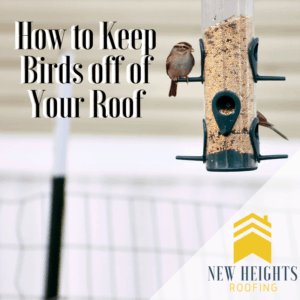
When it comes to roofing, you’d often be surprised at the things that can damage it. Sunlight and mold are the common surprises, but there are others. One that many homeowners don’t often consider is birds. All manner of wildlife can cause damage to your home, but birds can be a particular risk. This leads many homeowners looking for a reliable method for chasing birds off of their roof while doing as little harm as possible. Unsurprisingly, the internet is full of all kinds of seemingly odd and unique gizmos that claim to chase birds away by a variety of methods. While they may seem strange, some of these methods do work, and we thought we’d review a few general methods for keeping birds off of your roof.
Noise
The first method used to keep birds off of your roof involves using some kind of noise. Usually, these techniques involve creating a noise that either mimics the sounds created by predators, which chases the birds away, or simply creates some kind of discomfort for the birds. This is usually accomplished by placing some kind of speaker on your roof that plays the sounds. In some cases, this will be a sound that can be detected by human hearing, so you’ll need to find a balance between making it loud enough to be effective, but not so loud as to be irritating to yourself or your neighbors. Other devices are designed to play sounds from a sonic register that’s outside of the range of human hearing, so you won’t need to worry about the irritation. The effectiveness of these methods can be unreliable. Many devices that are advertised as generating bird repellent sounds may only work on a limited selection of birds. Different bird species will react in different ways, particularly with devices that are designed to operate outside of the range of human hearing. You’ll also need to check on local noise ordinances before installing such systems.
Surface treatment
Another general category of methods is going to be those that through various means physically prevent birds from landing on your roof. One of the more common are bird spikes, small sharp spikes made of either metal or plastic that make your roof uncomfortable for birds to land on. Bird spiders are long wired devices that resemble a large spider that spin around to make it harder for birds to land. Some homeowners will use large electrical pads that generate a slight shock to any bird that lands on them. Finally, some homeowners will use a bird repellent gel that makes the roof surface uncomfortable for the birds to land on. This gel has to be reapplied every 6-8 months. With all of these methods, you can expect to do some maintenance as they can sustain damage over time. Also, before installing any of the physical barriers to birds, you’ll want to use caution that you don’t damage your roof more than the birds ever would. Improperly installed brackets for bird spikes or spiders could puncture your roof underlayment or even decking, voiding any warranty you have and causing significant damage.
Visibility
One final category to be considered are methods that are based on the birds vision. This can include such devices that use motion or reflective surfaces to disrupt a bird’s sight causing confusion and discomfort, making your roof unattractive for landing on, or decoys or devices designed to cause a bird to believe a predator is present. This can range from unusually designed devices that look something like a weather vane with mirrors to simply a large plastic owl. Similar to the noise focused repellents, these methods will likely work more on some bird species than others.
Most of the damage birds can cause stems from birds pecking through roof material to get at seeds or insects that have become lodged within the roof shingles, as well as building nests using twigs and other debris storms and wind leave on your roof. Regular roof cleanings help keep these factors to a minimum and your roof looking its best.